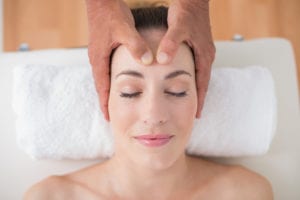Written by Angeline De Leon, Staff Writer. Burn patients groups who received either music, massage, or music and massage, experienced significant improvements in pain, anxiety, and relaxation compared to the control group receiving just primary care. These improvements were also significant in all three groups when comparing before intervention (baseline) to after intervention.
 Pain management in burn patients is a complex challenge for health care practitioners. Burn injuries involve different types of physical pain, including background rest pain, breakthrough pain that is difficult to control, and procedural pain related to wound dressings 1. The psychological trauma resulting from burn injury is also associated with long-term anxiety and stress which, in turn, disrupt wound healing and intensify existing physical pain. With absolute pain relief being virtually unobtainable, treatment options typically rely on the use of opioid analgesics and anti-anxiety medication, which are limited in efficacy and associated with numerous side effects 2. Among the most promising alternative, non-pharmacological interventions for pain management are massage therapy, which uses touching and soft tissue manipulation to promote cellular detoxification and relaxation, and music therapy, which functions to distract attention from pain, ease anxiety, and promote relaxation 3,4. Although large-scale methodological studies on the use of massage and music as complementary treatments are still needed, early research provides evidence for the therapeutic effectiveness of music therapy and massage therapy in general symptom management and their beneficial roles in post-surgery recovery 5. In a study published by Burns (2017), researchers at the Iran University of Medical Sciences evaluated the impact of massage and music on perceived pain and anxiety in burn patients in the Shahid Motahari Burns Hospital, Tehran, Iran.
Pain management in burn patients is a complex challenge for health care practitioners. Burn injuries involve different types of physical pain, including background rest pain, breakthrough pain that is difficult to control, and procedural pain related to wound dressings 1. The psychological trauma resulting from burn injury is also associated with long-term anxiety and stress which, in turn, disrupt wound healing and intensify existing physical pain. With absolute pain relief being virtually unobtainable, treatment options typically rely on the use of opioid analgesics and anti-anxiety medication, which are limited in efficacy and associated with numerous side effects 2. Among the most promising alternative, non-pharmacological interventions for pain management are massage therapy, which uses touching and soft tissue manipulation to promote cellular detoxification and relaxation, and music therapy, which functions to distract attention from pain, ease anxiety, and promote relaxation 3,4. Although large-scale methodological studies on the use of massage and music as complementary treatments are still needed, early research provides evidence for the therapeutic effectiveness of music therapy and massage therapy in general symptom management and their beneficial roles in post-surgery recovery 5. In a study published by Burns (2017), researchers at the Iran University of Medical Sciences evaluated the impact of massage and music on perceived pain and anxiety in burn patients in the Shahid Motahari Burns Hospital, Tehran, Iran.
A total of 240 burn patients (over 18 years old and with a burn injury affecting 10-45% of total body surface area) were enrolled in a randomized, controlled clinical trial where they were randomly assigned to one of four groups: a control group receiving conventional primary care (control); a music group which listened to recordings of their favorite songs (music); a massage group receiving Swedish massage (massage); and a music-plus-massage group receiving a combination of their favorite songs, along with Swedish massage (music-plus-massage). The music intervention involved the playing of four of the patient’s songs (wordless songs) using an MP3 player for 20 minutes daily for three days. Swedish massage was performed on healthy tissues by a trained practitioner for the same amount of time. A Visual Analogue Scale (VAS) was administered to assess pain intensity, anxiety intensity, and relaxation level.
Results revealed that although there was no significant difference among the interventions, for the music, massage, and combined intervention groups each, there was a significant decrease in pain (p < 0.001 for all) and anxiety (p < 0.001 for all) and a significant increase in relaxation level (p < 0.001 for all), relative to control. For each treatment group, a statistically significant improvement was also observed in pain intensity, anxiety intensity, and relaxation level (p < 0.001 for all) when comparing baseline (before intervention) to after intervention levels.
Thus, findings from the study indicate that the use of alternative, complementary therapies, consisting of music, massage, and a combination of both, can effectively mitigate the physical and emotional suffering associated with burn injury. Further studies are needed to determine the way in which each type of therapy may influence wound healing and how opioid use during treatment may change.
Source: Ghezeljeh TN, Ardebili FM, Rafi R. The effects of massage and music on pain, anxiety and relaxation in burn patients: Randomized controlled clinical trial. Burns. 2017; 43: 1034-1043. DOI: 10.1016/j.burns.2017.01.011.
© 2017 Elsevier Ltd and ISBI. All rights reserved.
Posted January 9, 2018.
References:
- Hinkle J, Cheever K. Brunner and Suddarth’s Textbook of Medical Surgical Nursing. 13th edition ed. Philadelphia: Lippincott Williams and Wilkins; 2014.
- Tan X, Yowler CJ, Super DM, Fratianne RB. The efficacy of music therapy protocols for decreasing pain, anxiety, and muscle tension levels during burn dressing changes: a prospective randomized crossover trial. Journal of Burn Care & Research. 2010;31(4):590-597.
- Clay JH. Basic clinical massage therapy: integrating anatomy and treatment. Lippincott Williams & Wilkins; 2008.
- Nilsson U. The effect of music intervention in stress response to cardiac surgery in a randomized clinical trial. Heart & Lung: The Journal of Acute and Critical Care. 2009;38(3):201-207.
- Hole J, Hirsch M, Ball E, Meads C. Music as an aid for postoperative recovery in adults: a systematic review and meta-analysis. The Lancet. 2015;386(10004):1659-1671.

